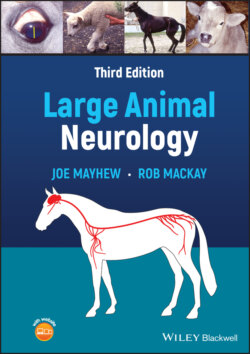Читать книгу Large Animal Neurology - Joe Mayhew - Страница 18
Overview
ОглавлениеTraditionally, a detailed neurologic examination follows the collection of information on a patient’s signalment and history, an evaluation of the environment, and a complete physical examination.1–13 However, during the evaluation of a large animal suspected of having a neurologic disorder, most busy practitioners include several components of a neurologic examination during variations of the general physical examination as listed in Table 2.1.
To distinguish between vertebral bodies and spinal cord segments, vertebral bodies and regions will be defined by site and standard numerals, whereas spinal cord segments will be defined by site with subscripted numerals. Thus, the last three cervical vertebrae are C5–7 and the last three cervical spinal cord segments are C6–8.
Sometimes enough evidence is available from this examination to proceed with a tentative diagnosis and therapy. However, if this initial general evaluation is not enough to make an accurate anatomic diagnosis, especially if a thorough case workup is warranted or requested, then a complete neurologic examination should be undertaken that will often uncover further neurologic findings helpful to case workup. In fact, even with second opinion cases, we usually go quite rapidly through a neurologic examination in say 5 min, then return to scrutinize major components of the examination dependent on clues from the history, physical examination, contributory test results, and initial examination. Even then, it can be useful to develop a mental list of further procedures to undertake to assist with this diagnostic process. These may include testing eye responses in dim and bright light, testing nasal and temporal field vision, and spinal reflex testing in smaller patients. Additionally, one may decide to return to observe the patient for facial expression and head posture when totally undisturbed, when blindfolded, during rising from recumbency or supported in a sling, and observed while performing its intended use, while maneuvering in a maze, after standing still for many minutes, after strenuous exercise, when frightened, after short acting sedatives and/or analgesic drugs, and when the patient is returned to its natural environment and herd/flock mates.
Table 2.1 The following tests and criteria can be evaluated in a physical examination to assist in the detection of a neurologic disorder
| Mental attitude/awareness | Symmetry of neck, trunk, and limbs |
|---|---|
| Normal behavior patterns | Tail and anal tone |
| Menace tests | Anal reflex |
| Pupillary light reflexes | Rectal examination |
| Fundoscopic examination | Postures adopted at rest |
| Symmetry of parts of the head | Proximal limb muscle bulk |
| Tongue position and tone | Gait at walk and trot |
| Absence of nasal discharge | Gait while turning |
| External thoracolaryngeal (slap) reflex | Faster gaits |
